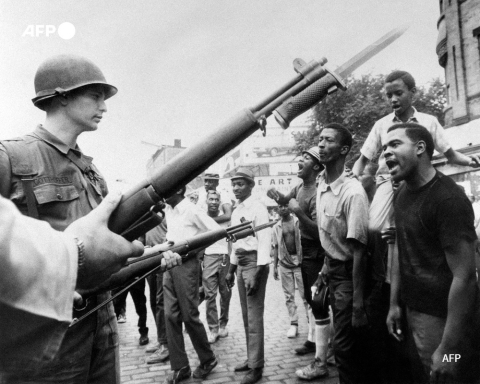A struggle marked by deadly violence

Although racial segregation was gradually eroded in US courts and parliaments, the civil rights struggle was punctuated in the 1960s by deadly violence.
Here are some examples drawn from AFP stories from the time.
- 1963: Birmingham church bombing -
The September 15, 1963 bombing of a Birmingham, Alabama church, which killed four little black girls and wounded another 20 children, is one of the most chilling incidents of the civil rights struggle.
The explosion during the Sunday service at the 16th Street Baptist Church came just 18 days after the historic "March on Washington".
It shocked Americans at a key moment in the fight against the racially motivated laws.
The attack was carried out by four Ku Klux Klan members, of whom one was sentenced to life in prison in 1977.
Two others were sentenced in 2001 and 2002 after the FBI reopened the investigation. The fourth was never charged.
- 1965: 'Bloody Sunday' in Selma -
On March 7, 1965 about 600 peaceful activists were attacked by police with clubs and tear gas at the Edmund Pettus Bridge in Selma, Alabama.
The brutal state suppression only catalyzed support for black rights and a few months later the Voting Rights Act was passed.
Before the act, it was easier for segregationist states like Alabama to restrict voter registration through violent intimidation and bureaucratic racism.
- 1965: Watts riots, LA -
On August 11, 1965 a routine identity check by police on two black men in a car sparked riots in the Los Angeles suburb of Watts that left 34 dead and 1,100 injured, and resulted in 4,000 arrests and $100 million in damage.
The trouble started when Marquette Frye, 21, and his half-brother were pulled over by a white policeman and taken in for questioning on suspicion of drunk driving.
Tempers rose. Two days later, hell broke loose in Watts. Barricades were set up in the streets while shops, warehouses and buses were set on fire and police were bombarded with Molotov cocktails and bricks.
The army was called in to quell the violence and imposed a curfew but the rioting continued for six days.

- 1967: Newark riots -
On July 12, 1967 a heated dispute between two white police officers and a black taxi driver set off rioting in Newark, New Jersey.
For five days, in stifling summer heat, rioters wrecked the district, leaving 26 dead and 1,500 injured.
- 1967: Detroit race riots -
Race riots from July 23 to 28, 1967 in Detroit, sparked by a police raid on a clandestine black bar, killed 43 and left hundreds more injured.
The violence spread to the states of Illinois, North Carolina, Tennessee and Maryland.
- 1968: King's killing -
From April 4 to 11, 1968, after the assassination of civil rights leader Martin Luther King, violence erupted in 125 cities, leaving at least 46 dead and 2,600 injured.
In Washington DC then president Lyndon B. Johnson sent in the 82nd Airborne Division to quell the unrest.
